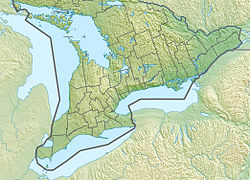- A view across the Otonabee river in Peterborough, Ontario, showing a part of the campus of Trent University. The Faryon bridge is to the right.
- Another view of the Faryon Bridge (reverse angle from previous), connecting the east and west banks of the Otonabee River
- Otonabee River as it flows past Peterborough County Road 32
| Otonabee River | |
|---|---|
 The Otonabee River in Bensfort Bridge, Ontario | |
| Etymology | From the Ojibwe Odoonabii-ziibi, meaning Tullibee River |
| Native name | Odoonabii-ziibi' (Ojibwe) |
| Location | |
| Country | Canada |
| Province | Ontario |
| Region | Central Ontario |
| County | Peterborough |
| Cities | |
| Physical characteristics | |
| Source | Katchewanooka Lake |
| • location | Selwyn |
| • coordinates | 44°25′54″N78°16′19″W / 44.43167°N 78.27194°W |
| • elevation | 233 m (764 ft) |
| Mouth | Rice Lake |
• location | Otonabee–South Monaghan |
• coordinates | 44°09′14″N78°13′52″W / 44.15389°N 78.23111°W |
• elevation | 187 m (614 ft) |
| Length | 55 km (34 mi) |
| Basin size | 806 km2 (311 sq mi) |
| Basin features | |
| River system | Great Lakes Basin |
The Otonabee River is a river in Peterborough County in Central Ontario, Canada. [1] The river flows from Katchewanooka Lake, at the north end of the community of Lakefield, through the city of Peterborough to Rice Lake. It is in the Great Lakes Basin and forms part of the Trent-Severn Waterway.



